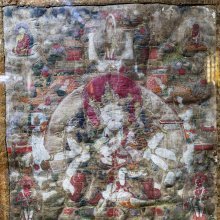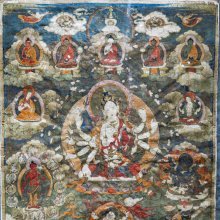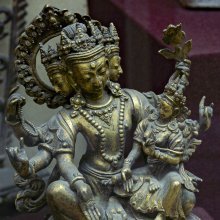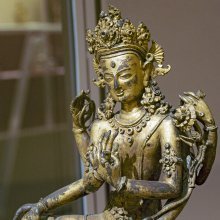Sukhavati, Sukhāvatī: 5 definitions
Introduction:
Sukhavati means something in Buddhism, Pali, Hinduism, Sanskrit. If you want to know the exact meaning, history, etymology or English translation of this term then check out the descriptions on this page. Add your comment or reference to a book if you want to contribute to this summary article.
Images (photo gallery)
(+8 more images available)
In Hinduism
Kavya (poetry)
Source: Wisdom Library: KathāsaritsāgaraSukhāvatī (सुखावती) is the sister of Kalāvatī and daughter of Amīla: a Daitya king from the second underworld, according to the Kathāsaritsāgara, chapter 45. The story of Sukhāvatī and Kalāvatī was narrated by the Vidyādhara king Vajraprabha to prince Naravāhanadatta in order to relate how “Sūryaprabha, being a man, obtain of old time the sovereignty over the Vidyādharas”.
According to the chapter 46, “... then Sūryaprabha went with all the rest into the presence of Amīla. He too was pleased on hearing that he had obtained boons, and gave him Sukhāvatī, his second daughter, and two of his sons to help him”.
The story of Sukhāvatī and Amīla was narrated by the Vidyādhara king Vajraprabha to prince Naravāhanadatta in order to relate how “Sūryaprabha, being a man, obtain of old time the sovereignty over the Vidyādharas”.
The Kathāsaritsāgara (‘ocean of streams of story’), mentioning Sukhāvatī, is a famous Sanskrit epic story revolving around prince Naravāhanadatta and his quest to become the emperor of the vidyādharas (celestial beings). The work is said to have been an adaptation of Guṇāḍhya’s Bṛhatkathā consisting of 100,000 verses, which in turn is part of a larger work containing 700,000 verses.

Kavya (काव्य, kavya) refers to Sanskrit poetry, a popular ancient Indian tradition of literature. There have been many Sanskrit poets over the ages, hailing from ancient India and beyond. This topic includes mahakavya, or ‘epic poetry’ and natya, or ‘dramatic poetry’.
In Buddhism
Mahayana (major branch of Buddhism)
Source: Wisdom Library: Maha Prajnaparamita SastraSukhāvatī (सुखावती) is the name of a universe according to the 2nd century Mahāprajñāpāramitāśāstra (chapter XV). Accordingly, “in the ten directions, there are other pure universes (pariśuddha-lokadhātu) such as the Ngan lo (Sukhāvatī) of the Buddha A mi t’o (Amitābha)”.

Mahayana (महायान, mahāyāna) is a major branch of Buddhism focusing on the path of a Bodhisattva (spiritual aspirants/ enlightened beings). Extant literature is vast and primarely composed in the Sanskrit language. There are many sūtras of which some of the earliest are the various Prajñāpāramitā sūtras.
Tibetan Buddhism (Vajrayana or tantric Buddhism)
Source: archive.org: The Indian Buddhist Iconography1) Sukhāvatī (सुखावती) or Sukhāvatīlokeśvara refers to one of the various forms of Avalokiteśvara, as described in the Dharmakośasaṃgraha.—His Colour is white; His Āsana is the lalita; He has three faces and six arms.—A description of the deity [viz., Sukhāvatī] occurs in the Dharmakośasaṃgraha of Amṛtānanda. Nepal abounds in images of Sukhāvatī Lokeśvara both in stone and in bronze, though his images are not found in any other Buddhist country of the North.
Sukhāvatī is described in the Dharmakośasaṃgraha as follows:
“Sukhāvatī Lokeśvara is three-faced, white in colour, and six-armed. One of his right hands is in the act of shooting an arrow, the remaining two have the rosary and the varada pose. In two of his left hands he carries the bow and the lotus, and the third is placed on the thigh of Tārā. He sits in lalitāsana on the lotus, and is surrounded by the goddesses Vajratārā, Viśvatārā, Padmatārā and the like. There is a caitya on the top.”
2) Sukhāvatī (सुखावती) or Sukhāvatīlokeśvara refers to number 13 of the 108 forms of Avalokiteśvara found in the Machhandar Vahal (Kathmanu, Nepal). [Machhandar or Machandar is another name for for Matsyendra.].
Accordingly,—
“Sukhāvatī is one-faced, and six-armed, and sits on a lotus in the Lalita attitude. The first pair of hands exhibits the Dharmacakra-mudrā, the second pair carries the rosary and the book, and the third pair shows the Varada mudrā in the right and the water-pot in the left”.
The names of the 108 deities [viz., Sukhāvatī] possbily originate from a Tantra included in the Kagyur which is named “the 108 names of Avalokiteshvara”, however it is not yet certain that this is the source for the Nepali descriptions. Tibetan Buddhism includes schools such as Nyingma, Kadampa, Kagyu and Gelug. Their primary canon of literature is divided in two broad categories: The Kangyur, which consists of Buddha’s words, and the Tengyur, which includes commentaries from various sources. Esotericism and tantra techniques (vajrayāna) are collected indepently.
Languages of India and abroad
Sanskrit dictionary
Source: Cologne Digital Sanskrit Dictionaries: Edgerton Buddhist Hybrid Sanskrit DictionarySukhāvatī (सुखावती).—(compare sukhākarā), with or sc. lokadhātu, the world of Amitābha or Amitāyus, from which Ava- lokiteśvara also comes (Kāraṇḍavvūha 17.21 ff.; but in Kāraṇḍavvūha also it is Amitābha's world, 21.8, compare 18.7): Kāraṇḍavvūha 13.22; 17.6, 22; Saddharmapuṇḍarīka 419.3; 455.1; Mahāvyutpatti 3067; Bhadracarī 57; Gaṇḍavyūha 82.5; Śikṣāsamuccaya 175.5; Samādhirājasūtra p. 9 line 31; (Ārya-)Mañjuśrīmūlakalpa 610.7; 617.3; Laṅkāvatāra-sūtra 283.7; 286.15; Sukhāvatīvyūha 1.7; 28.10; 32.17 etc.
Source: Cologne Digital Sanskrit Dictionaries: Monier-Williams Sanskrit-English Dictionary1) Sukhavatī (सुखवती):—[=sukha-vatī] [from sukha > sukh] f. Name of the heaven of Buddha Amitābha (See under sukhā-vat, [column]3), [Buddhist literature]
2) Sukhāvatī (सुखावती):—[=sukhā-vatī] [from sukhā-vat > sukha > sukh] f. Name of the paradise or heaven of Amitābha (situated in the western sky), [Buddhist literature; Saddharma-puṇḍarīka; Kāraṇḍa-vyūha; Monier-Williams’ Buddhism 183, 204]
3) [v.s. ...] of the wife of Sūrya-prabha, [Kathāsaritsāgara]
Sanskrit, also spelled संस्कृतम् (saṃskṛtam), is an ancient language of India commonly seen as the grandmother of the Indo-European language family (even English!). Closely allied with Prakrit and Pali, Sanskrit is more exhaustive in both grammar and terms and has the most extensive collection of literature in the world, greatly surpassing its sister-languages Greek and Latin.
See also (Relevant definitions)
Starts with: Sukhavatideva, Sukhavatilokeshvara, Sukhavatishvara, Sukhavativyuha, Sukhavativyuha Sutra.
Full-text (+208): Saukhavati, Sukhavativyuha, Sukhavatishvara, Sukhakara, Unminja, Uposhaniyaprabha, Rajaniyaprabha, Anupalipta, Asamaptaprabha, Arthavasha, Kusumabhijna, Jvalanadhipati, Ratnashri, Caryacarana, Pancamandalanamaskara, Amitaprabha, Amitaprabhasa, Asamgataprabha, Balabhijna, Bodhiparinishpatti.
Relevant text
Search found 25 books and stories containing Sukhavati, Sukhāvatī, Sukhavatī, Sukha-vati, Sukha-vatī, Sukhā-vatī; (plurals include: Sukhavatis, Sukhāvatīs, Sukhavatīs, vatis, vatīs). You can also click to the full overview containing English textual excerpts. Below are direct links for the most relevant articles:
The Practice Manual of Noble Tārā Kurukullā (by Dharmachakra Translation Committee)
Chapter 3 < [Appendix - Sanskrit Text]
The Indian Buddhist Iconography (by Benoytosh Bhattachacharyya)
Figure 119 - (Avalokiteśvara): Sukhāvatī Lokeśvara
The Larger Sukhavativyuha Sutra
The Great Chariot (by Longchenpa)
Part 3 - The motivating power of compassion < [C. The three instructions of striving]
Part 2 - The Teaching of the Benefits < [D. The final summary]
Part 3e.2a - The self-existing nirmanakaya < [B. The explanation of the kayas and wisdoms]
Maha Prajnaparamita Sastra (by Gelongma Karma Migme Chödrön)
Part 4 - Illuminating the darkness of the intermediary worlds < [Chapter LI - Seeing all the Buddha Fields]
Act 10.9: The transformed Sahā universe compared with the Padmāvatī universe < [Chapter XV - The Arrival of the Bodhisattvas of the Ten Directions]
II. Hearing the name of the Buddhas < [Part 3 - Bringing innumerable beings to abhisaṃbodhi]
Related products






